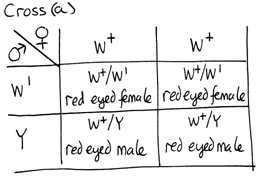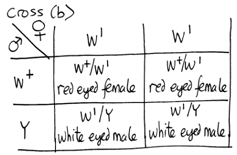Answers
3.1 There is a maximum of two alleles for a normal autosomal locus in a diploid species.
3.2 a) In the F1 generation, the genotype of all individuals will be Ww and all of the dogs will have wirey hair.
b) In the F2 generation, there would be an expected 3:1 ratio of wirey-haired to smooth-haired dogs.
c) Although it is expected that only one out of every four dogs in the F2 generation would have smooth hair, large deviations from this ratio are possible, especially with small sample sizes. These deviations are due to the random nature in which gametes combine to produce offspring. Another example of this would be the fairly common observation that in some human families, all of the offspring are either girls, or boys, even though the expected ratio of the sexes is essentially 1:1.
d) You could do a test cross, i.e. cross the wirey-haired dog to a homozygous recessive dog (ww). Based on the phenotypes among the offspring, you might be able to infer the genotype of the wirey-haired parent.
e) From the information provided, we cannot be certain which, if either, allele is wild-type. Generally, dominant alleles are wild-type, and abnormal or mutant alleles are recessive.
3.3 Even before the idea of a homozygous genotype had really been formulated, Mendel was still able to assume that he was working with parental lines that contained the genetic material for only one variant of a trait (e.g. EITHER green seeds of yellow seeds), because these lines were pure-breeding. Pure-breeding means that the phenotype doesn’t change over several generations of self-pollination. If the parental lines had not been pure-breeding, it would have been very hard to make certain key inferences, such as that the F1 generation could contain the genetic information for two variants of a trait, although only one variant was expressed. This inference led eventually to Mendel’s First Law.
3.4 Equal segregation of alleles occurs only in meiosis. Although mitosis does produce daughter cells that are genetically equal, there is no segregation (i.e. separation) of alleles during mitosis; each daughter cell contains both of the alleles that were originally present.
3.5 If your blood type is B, then your genotype is either IBi or IBIB. If your genotype is IBi, then your parents could be any combination of genotypes, as long as one parent had at least one i allele, and the other parent had at least one IB allele. If your genotype was IB IB, then both parents would have to have at least one IB allele.
3.6 case 1 co-dominance
case 2 incomplete-dominance
case 3 incomplete penetrance
case 4 pleiotropy
case 5 haplosufficiency
case 6 haploinsufficiency
case 7 broad (variable) expressivity
3.7 If the gene is autosomal, the probability is 50%. If it is sex-linked, 100%. In both situations the probability would decrease if the penetrance was less than 100%.
3.8
3.9 Note that a semicolon is used to separate genes on different chromosomes.
| | Phenotype | Genotype(s) |
| a | entirely black | OB / OB ; s / s OB / Y ; s / s |
| b | entirely orange | O0 / O0 ; s / s O0 / Y ; s / s |
| c | black and white | OB / OB ; S / _ OB / Y ; S / _ |
| d | orange and white | O0 / O0 ; S / _ O0 / Y ; S / _ |
| e | orange and black (tortoiseshell) | O0 / OB ; s / s |
| f | orange, black, and white (calico) | O0 / OB ; S / _ |
3.10

3.11 Because each egg or sperm cell receives exactly one sex chromosome (even though this can be either an X or Y, in the case of sperm), it could be argued that the sex chromosomes themselves do obey the law of equal segregation, even though the alleles they carry may not always segregate equally. However, this answer depends on how broadly you are willing to stretch Mendel’s First Law.
3.12 Co-dominance
3.13 People with hemophilia A use injections of recombinant Factor VIII proteins on demand (to control bleeding) or regularily (to limit damage to joints).







